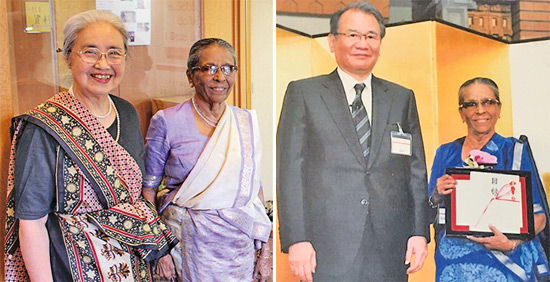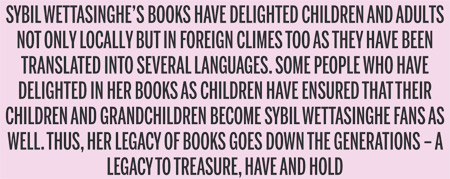
Sybil Wettasinghe, the iconic and much loved author and illustrator of children’s books bade adieu to this world a year ago, on June 30, 2020. Her books have delighted children and adults not only locally but in foreign climes too as they have been translated into several languages. Some people who have delighted in her books as children have ensured that their children and grandchildren become Sybil Wettasinghe fans as well. Thus, her legacy of books goes down the generations – a legacy to treasure, have and hold. Even though Sybil is no more, her books are still best sellers. Her books reached out to a wide spectrum of readers from little children, teens and adults as well.
 She was born in rural, Southern Sri Lanka in the village of Gintota on October 31, 1928. Her parents were Sawderis and Joslin Silva. Sybil was the second in the family.
She was born in rural, Southern Sri Lanka in the village of Gintota on October 31, 1928. Her parents were Sawderis and Joslin Silva. Sybil was the second in the family.
She had her initial education at the village school now the Gintota Maha Vidyalaya. When Sybil was six years of age, the family relocated to Colombo. Sybil and her two sisters were admitted to Holy Family Convent, Bambalapitiya. It was at Holy Family Convent that Sybil first made a name for herself as an artist.
She was always drawing on her books. These included sketches of fellow students and teachers as well as cartoons of them. This brought Sybil into the limelight. A teacher, Eileen Dissanayake asked Sybil to illustrate the poem, Lochinvar, and once done, hung the drawings like a mural on a wall. This really established Sybil as an artist within the Convent.
An emerging artist
 Sybil broke her mirror one day and was inspired to do her self portrait of her face among the broken shards of mirror. This was exhibited at the 1942 exhibition of the Ceylon of Society of Art where it caught the attention of H. D. Sugathapala, the then Headmaster of the Royal Primary and author of the supplementary reader series Navamaga. He was impressed by the painting. He and his wife Gertie approached Sybil’s mother Joslin and got her consent for Sybil, just 17 years at the time to illustrate the Standard Five reader of Navamaga. The self-taught teen aged artist’s illustrations inspires art students even today.
Sybil broke her mirror one day and was inspired to do her self portrait of her face among the broken shards of mirror. This was exhibited at the 1942 exhibition of the Ceylon of Society of Art where it caught the attention of H. D. Sugathapala, the then Headmaster of the Royal Primary and author of the supplementary reader series Navamaga. He was impressed by the painting. He and his wife Gertie approached Sybil’s mother Joslin and got her consent for Sybil, just 17 years at the time to illustrate the Standard Five reader of Navamaga. The self-taught teen aged artist’s illustrations inspires art students even today.
Sybil also illustrated an English reader, English with a Smile. In 1959, Sybil was invited by Narada Thera of the Vajiraramaya Temple, Bambalapitiya to illustrate Sadhaham Maga, a supplementary reader on Buddhism for children. Singular honour came Sybil’s way when renowned author Martin Wickramasinghe asked Sybil to illustrate his book Ape Gama. It also brought her another benefit as her mother took a more lenient attitude towards her art as Martin Wickramasinghe was her favourite author.
Newspaper career
Mentor H.D. Sugathapala and wife introduced Sybil Wettasinghe to journalism by taking her to the Lankadeepa. H.D Sugathapala also introduced Sybil to D. B. Dhanapala, Editor of Lankadeepa. From the moment Sybil stepped into the Lankadeepa, she knew that this was where she wanted to be.
“That is where I want to work. I want to draw illustrations for a newspaper” is what Sybil told her mother when she returned home.
Sybil initially drew a weekly cartoon strip illustrating a folk poem. As a self-taught artist, she had her own, unique style blended with humour in her illustrations. Editor D. B. Dhanapala allowed and encouraged Sybil to follow her own style, which gave her much-valued creative freedom and helped her develop as a unique artist. Soon, Sybil was also working for the English paper, Times.
In 1952, Sybil moved to Lake House to work for the evening paper, Janatha as an illustrator. Soon she was illustrating for almost all the feature pages of the Lake House papers and enjoying illustrating the children’s page of Janatha.
Kuda Hora
It was the Janatha’s chief sub editor Dharmapala Wettasinghe who encouraged Sybil to write her first story Kuda Hora (Umbrella Thief). It was an instant best seller and initially published as a Navamaga supplementary reader with lovely black and white illustrations. In 1983, Sybil re-illustrated Kuda Hora in colour. With a translation, The Umbrella Thief qualified for the Noma Concours Picture Book Illustrations Competition in Japan and won the third prize for the illustrations.

After this, the Fukutake Publishing Company of Japan translated Kuda Hora into Japanese and published it in Japan. This delightful book has also been published in Korea, Denmark, Sweden and China. Colour and black and white versions of Kuda Hora has been in publication in Sri Lanka for 65 years making it an iconic book in Sri Lanka’s children’s literature.
During her illustrious and unique career, Sybil Wettasinghe has written over 250 children’s books all illustrated by herself.
Vesak Pahana (Vesak Lantern in English), Kevum Yodhaya. Meti gedera lamai (Crystal and Clay in English), Sooththara Puncha, Pulun Baba, Uda giya baba Thunapaha kavi and her two autobiographies, Child in me (Veniyan kalu veniyan in Sinhala) and Eternally yours (Nomiyena kalu duu in Sinhala) rank among Sybil’s most popular books.
Kusumalatha and Yasawathi are two weekly columns by Sybil based on daily city living in a woman’s eyes. They were also very popular with readers.
Sybil wrote in both Sinhala and English, and many of her books were translated into Tamil.
Sybil has won recognition and awards both in the country, region and internationally.
Recognition
Among the local awards are the State National Honours of Kala Suri, Kala Keerthi and Kala Bhushana. She has also been offered an Honorary Doctorate by the University of Aesthetic Studies.
Eight of Sybil’s children’s books have won national state literary awards as the Best Children’s Book and the award for the best produced book/best cover page of children’s book several times. Sybil won the Solis Mendis award in 2007, presented to commemorate the life of the prestigious fresco painter, Solius Mendis who painted the frescoes of Kelaniya Rajamaha Vihara.
Sybil considered this a special honour as she was an ardent admirer of Solis Mendis’s work. Her autobiography of her early years in the village, The Child in Me won the Gratiaen Prize for the Best English book in 1995, the award she shared with Rajiv Wijesinghe for a book published in the same year.
Sybil with a collective of children won the Guinness Record for the book with the highest number of endings for a single story.
Among the International Awards won by Sybil are the Isobel Hutton prize by the Women’s Council of England, for Asian women writers, presented in 1965, for the story of The Vesak Lantern. In 1987, The Biennale of Illustrations in Bratislava (BIB), one of world’s highest recogniised awards for children’s book illustrations presented a prize for Sybil for her illustrations done for the Children’s Bible, Deeptha Lama Maga, published by the Ceylon Bible Society to commemorate their 175th anniversary. Kuda Hora won the Best Book Award by a foreign author, published in Japan in 1983 and was also the Most Popular Book, voted by the children of Japan in 1986.
Family
Sybil married Dharmapala Wettasinghe, a well-known journalist and editor of several newspapers, including Dinamina, SIlumina and the Daily News. He was also the Chief Subeditor of Janatha when Sybil joined the paper and was the one who encouraged her to write Kuda Hora. Suriya, Sashi, Kusala and Vinod are Sybil and Dharmapala’s four children.
The eldest son, Suriya, passed away in May 2020 a little while before Sybil’s death in June. Her grandchildren were one of the greatest joys in Sybil’s life. She has five grandchildren, Dulkith, Shalini, Anudath, Anupama and Paramee.
Sybil was active even at the age of 92 and was so until she was suddenly taken ill on June 27, 2020 and passed away on June 30.
